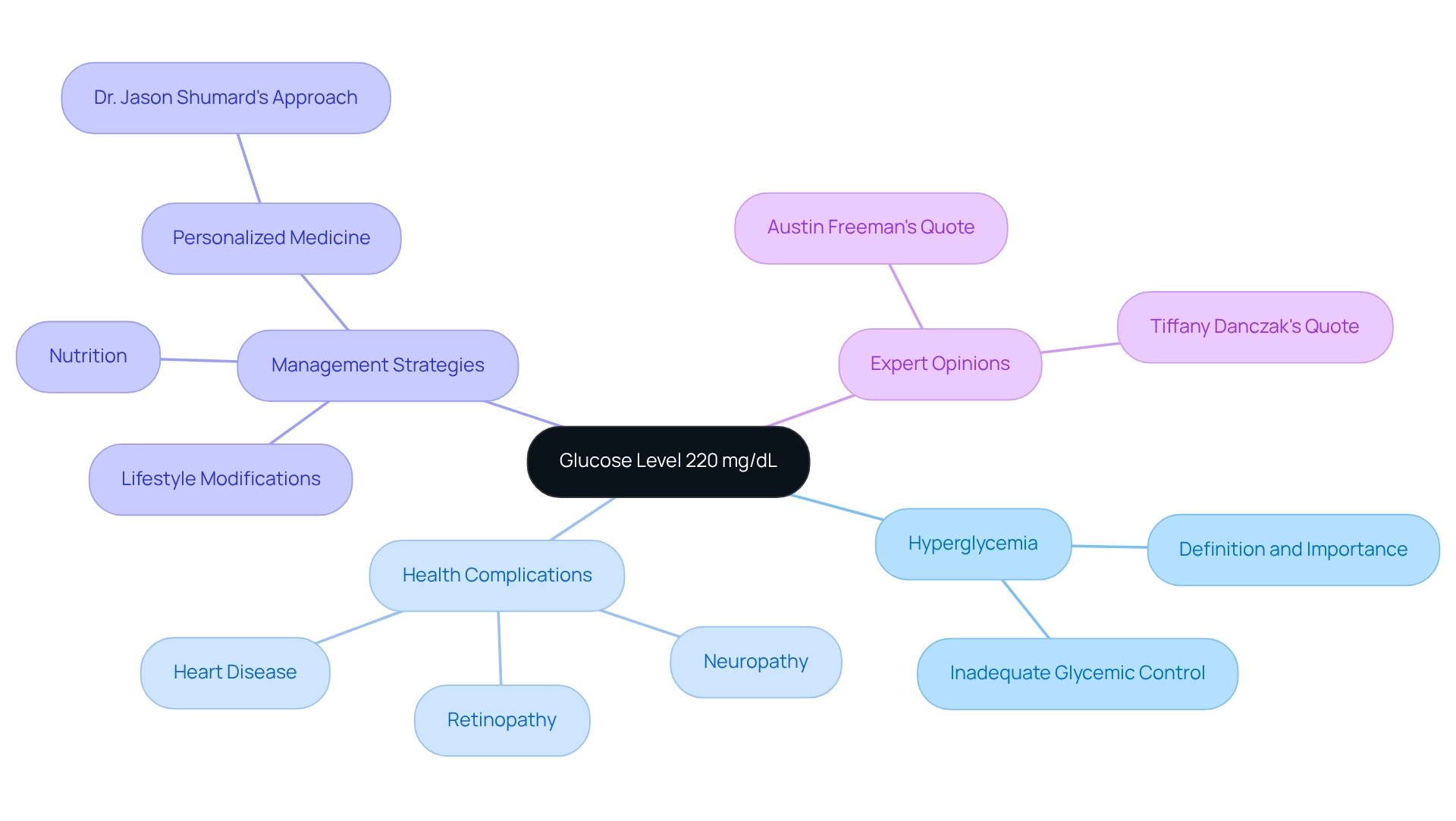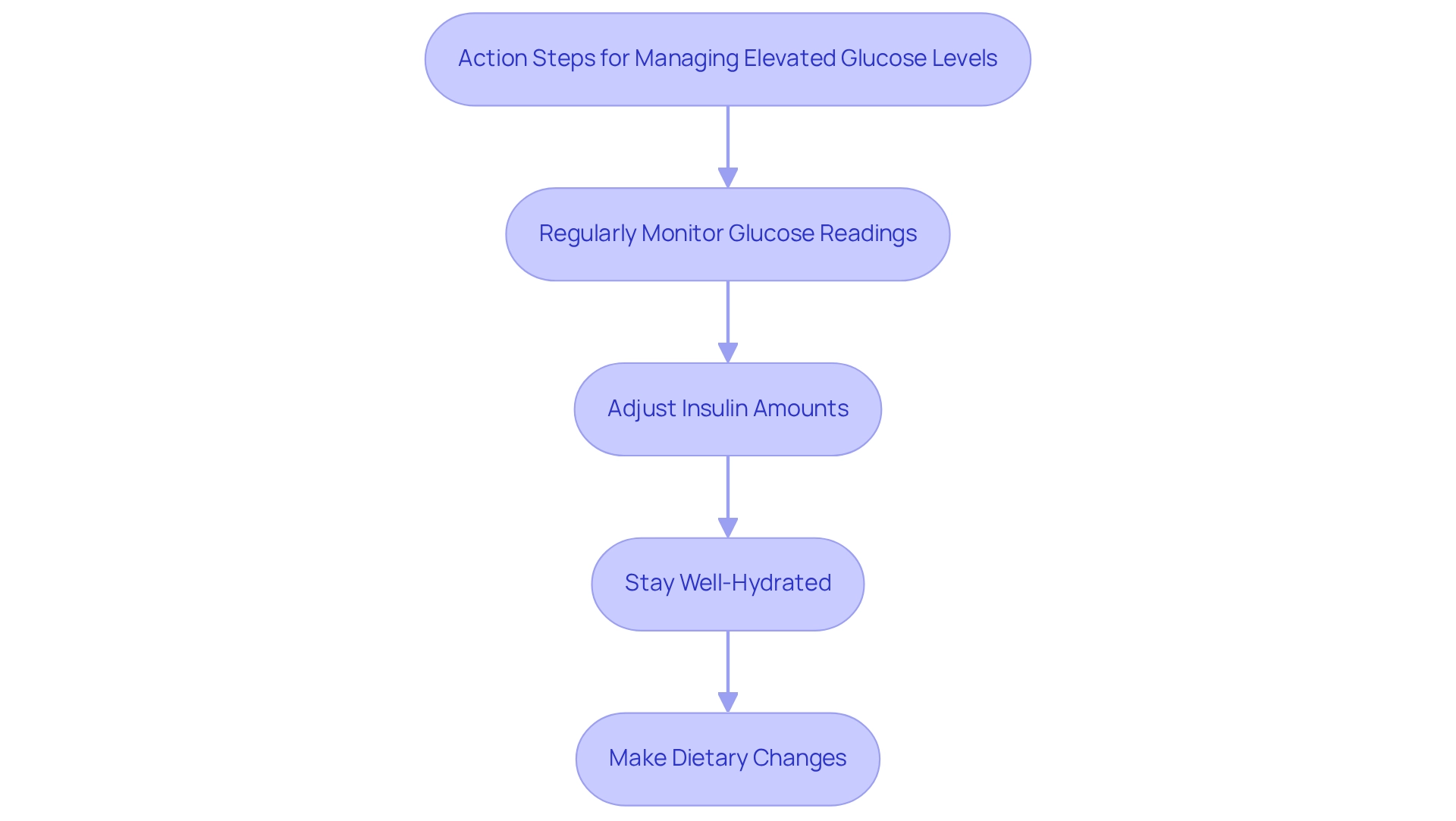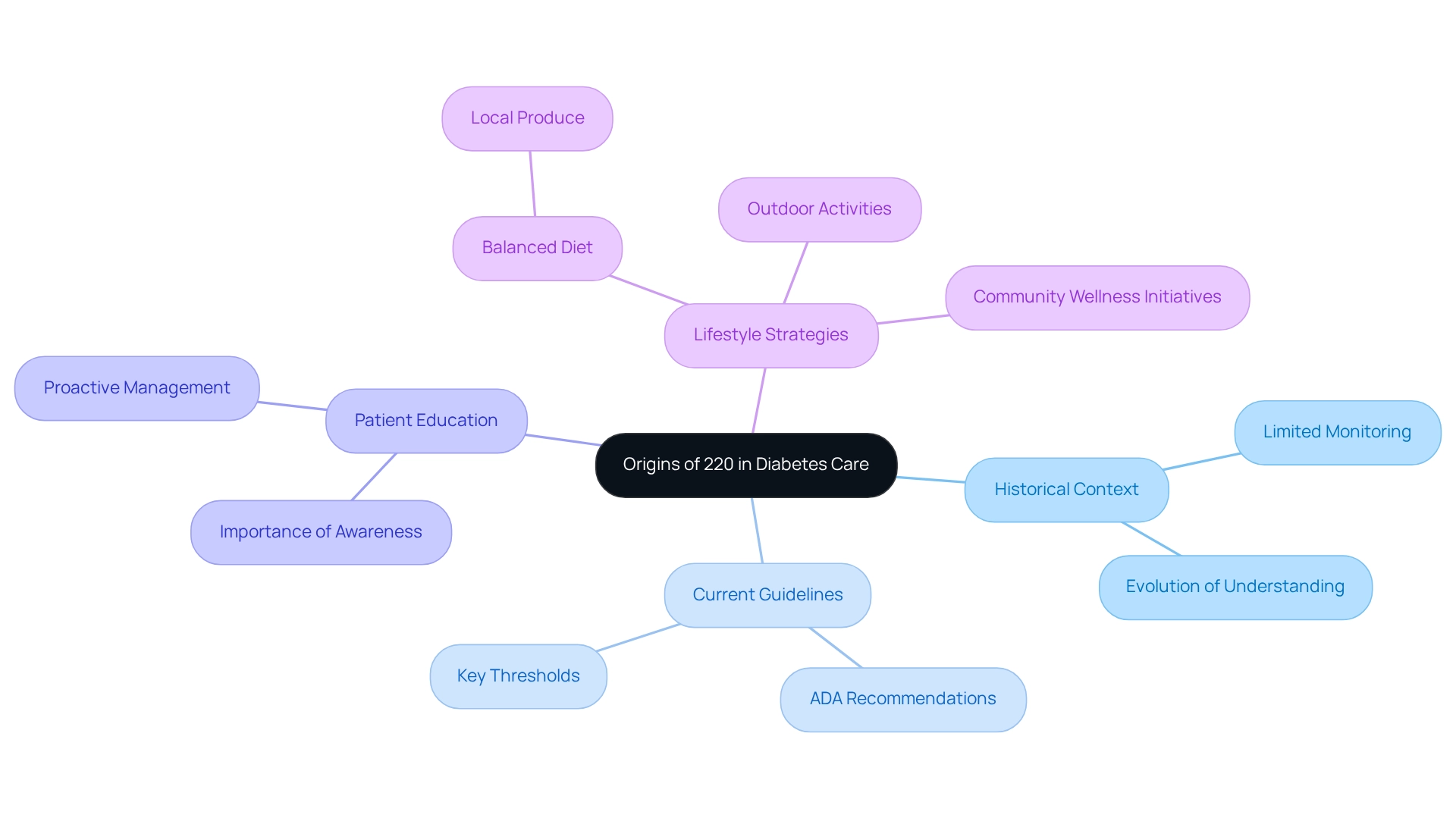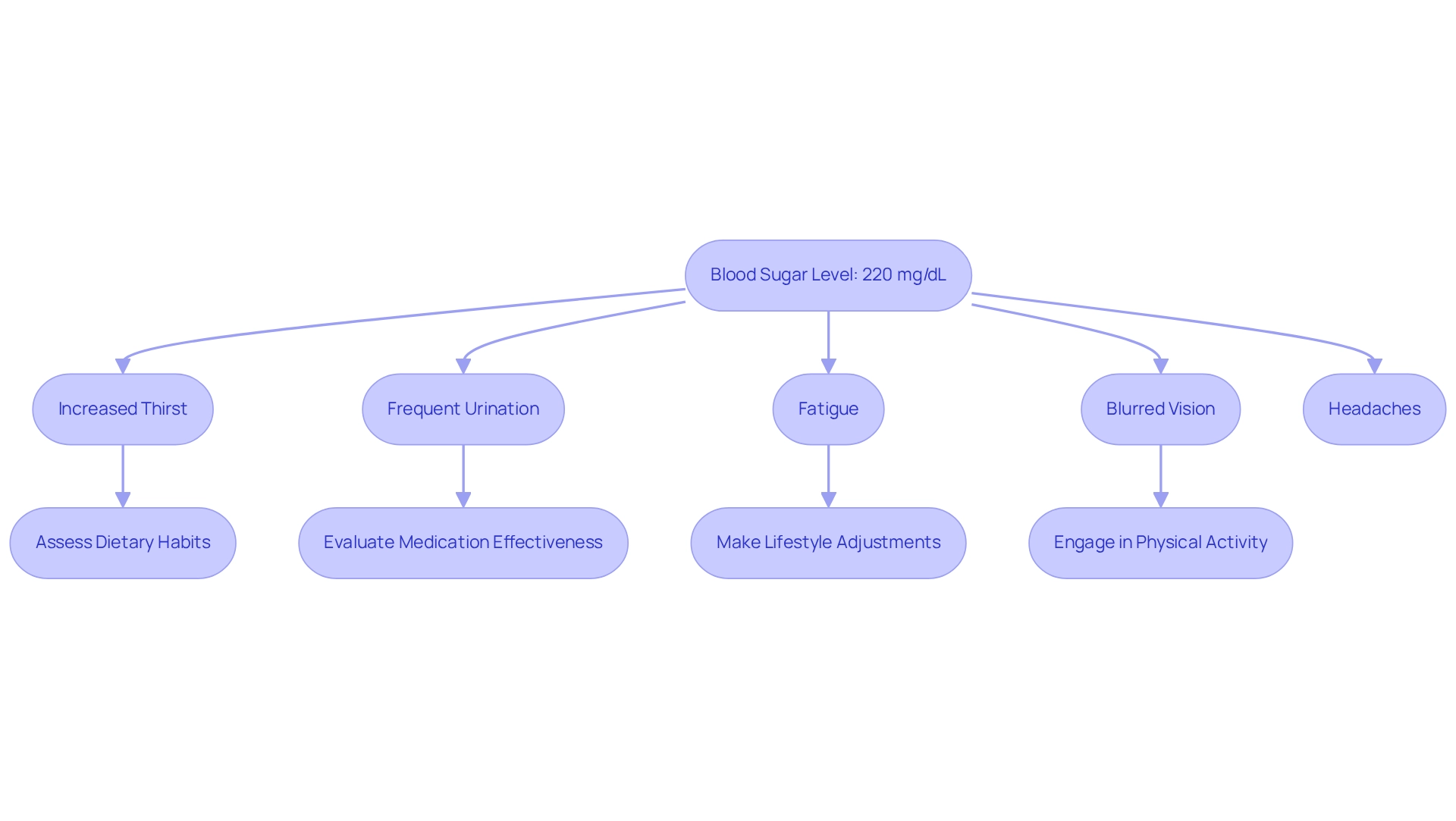Overview
A glucose concentration of 220 mg/dL is a critical indicator of hyperglycemia, and it’s important to recognize that this signals the need for immediate intervention.
Understanding this threshold is essential for both patients and healthcare providers, as it helps evaluate treatment effectiveness and guides necessary lifestyle changes.
Many patients find that by addressing these concerns proactively, they can significantly improve their health outcomes.
Embracing these management strategies can lead to a more fulfilling life and better control over diabetes.
Introduction
In the realm of diabetes management, it’s important to recognize the implications of a blood sugar level of 220 mg/dL. This threshold signifies hyperglycemia and serves as a critical marker that can lead to serious health complications if not addressed promptly. With diabetes on the rise, largely due to lifestyle factors such as obesity and inactivity, many patients find that the need for effective management strategies has never been more urgent.
By delving into the physiological responses triggered at this level and understanding the historical context of its significance, individuals can gain valuable insights into maintaining their health. Emphasizing a holistic approach, experts advocate for personalized strategies that empower patients to take charge of their diabetes. This not only ensures a better quality of life but also reduces the risk of long-term complications.
Have you ever felt overwhelmed by the challenges of managing your blood sugar? You’re not alone. Many find that by taking proactive measures, they can navigate these challenges with greater confidence. The journey toward effective control is one that can lead to a healthier and more fulfilling life.
Define 220: A Key Concept in Diabetes Management
A glucose concentration of 220 mg/dL is considered high and typically indicates hyperglycemia, a common concern for those managing their health. This measurement is critical, as it often points to inadequate glycemic control, which can lead to various health complications if not addressed. It’s important to recognize that the prevalence of diabetes has surged in recent years, largely due to rising obesity rates and sedentary lifestyles. This situation highlights the urgency of effective management strategies. Keeping glucose concentrations below this limit is essential for preventing long-term issues like neuropathy, retinopathy, and heart disease.
Many patients find that understanding what a reading of 220 mg/dL means allows them and their healthcare providers to evaluate the effectiveness of treatment plans and necessary lifestyle changes. Dr. Jason Shumard’s holistic methodologies focus on addressing the underlying causes of chronic conditions, offering a unique approach to managing hyperglycemia through personalized functional medicine. His emphasis on tailored nutrition and lifestyle modifications empowers patients to take control of their health.
If you’re looking to restore your health, call 858-564-7081 to discover how Dr. Shumard can assist you! Furthermore, expert opinions emphasize that consistent monitoring and proactive management of blood sugar levels are vital in reducing the risks associated with hyperglycemia. As Tiffany Danczak wisely stated, ‘Don’t let yourself fall; you gotta pick yourself right up and strive to do better and be better!’ This proactive mindset is crucial for improved health outcomes.
Additionally, the case study on addressing the underlying causes of chronic conditions demonstrates the practical application of these concepts, reinforcing the significance of a comprehensive strategy for managing diabetes-related issues. Ultimately, acknowledging the potential health complications linked to hyperglycemia, particularly a reading of 220 mg/dL, is essential for effective management of the condition.
Contextualize 220: Its Importance in Managing Diabetes
Managing your condition can feel overwhelming, especially when it comes to understanding what a glucose concentration of 220 mg/dL means. This level signals the need for prompt intervention, as it can lead to acute symptoms like increased thirst, frequent urination, fatigue, and blurred vision. If not addressed, prolonged high glucose levels can result in severe complications, such as diabetic ketoacidosis (DKA) and hyperglycemic hyperosmolar state (HHS), both of which require urgent medical attention. It’s crucial to note that patients with random glucose readings exceeding 125 mg/dL during hospitalization should have follow-up testing for diabetes within one month of discharge. This highlights the importance of timely monitoring, particularly for those who need to understand what 220 mg/dL signifies, to prevent complications and ensure effective management.
Real-life experiences illustrate how to manage symptoms at this critical stage. For example, tailored insulin strategies are vital for patients on enteral feeding, as different feeding formulas can greatly influence glycemic control. Balancing basal and correction doses is essential to maintain stable glucose readings, especially when numbers are elevated.
When glucose concentration reaches 220 mg/dL, taking immediate action is important. This includes:
- Regularly monitoring your glucose readings
- Adjusting insulin amounts as directed
- Ensuring you stay well-hydrated
- Making dietary changes—like reducing carbohydrate intake and employing meal-planning strategies that enhance your satisfaction
Experts emphasize that consistent monitoring and proactive management strategies are key to preventing acute complications and improving overall health outcomes.
As Tiffany Danczak wisely stated, “Don’t let yourself fall, you gotta pick yourself right up and strive to do better and be better!” This mindset is vital for anyone managing their condition, especially when facing the challenges of elevated glucose levels. By setting structured goals and tracking your progress regularly, you can foster a sense of achievement and stay engaged in your health management journey.
Trace the Origins of 220 in Diabetes Care
Understanding glucose concentration, particularly when it reaches 220 mg/dL, is crucial in managing blood conditions. Over the years, our awareness of its significance has evolved through extensive research and clinical experience. In earlier times, glucose measurements were not closely monitored, leading to a limited understanding of their long-term implications. However, organizations like the American Diabetes Association (ADA) have since established guidelines that highlight key thresholds for glucose levels. It’s important to recognize that 220 mg/dL is seen as a concerning threshold due to research linking elevated glucose levels to increased risks of complications.
Many patients find that this evolution in understanding reflects a broader awareness of the need for proactive diabetes management. This emphasizes the importance of patient education and regular monitoring. In San Marcos, CA, effectively managing blood sugar can be greatly enhanced by adopting holistic lifestyle strategies. Imagine incorporating a balanced diet rich in local produce, engaging in regular outdoor activities, and participating in community wellness initiatives—these steps can significantly help stabilize glucose levels.
Personalized functional medicine approaches, such as tailored nutrition plans and testing, empower individuals to manage their diabetes more effectively, often without relying on insulin. By focusing on these comprehensive strategies, patients can not only achieve better health outcomes but also enhance their overall well-being. Remember, taking small, manageable steps can lead to significant improvements in your health journey.
Identify Key Characteristics of 220 in Diabetes Management
A blood sugar concentration of 220 mg/dL can trigger several physiological responses, such as increased thirst (polydipsia), frequent urination (polyuria), and fatigue. These symptoms often arise as the body struggles to manage elevated glucose levels in the bloodstream. Many patients also report experiencing blurred vision and headaches, common indicators of hyperglycemia. It’s important to acknowledge that all participants with type 2 metabolic disorder had lower rates of major cardiovascular disease outcomes (< 1%) over 3.4 years, highlighting the critical need for effective management strategies.
To address these challenges, patients should:
- Regularly assess their dietary habits
- Evaluate the effectiveness of their medications
- Make necessary lifestyle adjustments
Engaging in consistent physical activity, monitoring carbohydrate intake, and adhering to prescribed treatments are crucial steps in maintaining blood sugar levels within a healthier range. Dr. Jason Shumard, D.C., at Integrative Wellness Center, emphasizes the significance of personalized functional medicine approaches tailored to individual needs, which can greatly enhance the management of blood sugar conditions. As Dr. Romesh Khardori, MD, PhD, wisely states, “Inability to achieve adequate glycemic control usually should be a clear indication to consult a specialist in managing blood sugar issues.”
By understanding these essential traits and their consequences, patients can take proactive steps in their health management journey, ultimately leading to improved health outcomes. Additionally, recognizing the underlying causes of type 2 diabetes and hypothyroidism is vital, as addressing these root issues can significantly enhance symptom management. A case study on insulin infusion protocols in ICU patients underscores the importance of frequent glucose monitoring and adjustments to insulin infusion rates to achieve optimal glycemic control. This comprehensive approach empowers patients to reclaim their health and well-being.
Conclusion
Recognizing a blood sugar level of 220 mg/dL as a significant marker of hyperglycemia is crucial for effective diabetes management. This threshold not only signifies inadequate glycemic control but also serves as a warning sign for potential health complications such as:
- Neuropathy
- Retinopathy
- Cardiovascular diseases
It’s important to understand that proactive monitoring and personalized strategies can help maintain blood sugar levels below this critical point, enhancing the quality of life for individuals with diabetes.
Many patients find that understanding the historical context surrounding diabetes care highlights the growing need for rigorous monitoring and immediate intervention at elevated blood sugar levels. If you experience symptoms like:
- Increased thirst
- Fatigue
- Blurred vision
it’s essential to take swift action. Adjusting insulin dosages and modifying dietary habits can make a significant difference. Integrating personalized functional medicine approaches and holistic lifestyle strategies is vital for empowering you to manage your diabetes effectively.
Ultimately, the journey towards better diabetes management involves consistent effort, education, and a proactive mindset. By recognizing the implications of a 220 mg/dL reading and implementing tailored strategies, you can navigate the complexities of diabetes with confidence. This approach not only minimizes the risk of serious complications but also fosters a sense of control and empowerment in managing your health.
Frequently Asked Questions
What does a glucose concentration of 220 mg/dL indicate?
A glucose concentration of 220 mg/dL is considered high and typically indicates hyperglycemia, which suggests inadequate glycemic control.
Why is it important to manage glucose concentrations below 220 mg/dL?
Keeping glucose concentrations below this limit is essential to prevent long-term health issues such as neuropathy, retinopathy, and heart disease.
What factors have contributed to the rise in diabetes prevalence?
The prevalence of diabetes has surged due to rising obesity rates and sedentary lifestyles.
How can understanding glucose readings benefit patients?
Understanding what a reading of 220 mg/dL means allows patients and their healthcare providers to evaluate the effectiveness of treatment plans and necessary lifestyle changes.
What approach does Dr. Jason Shumard take towards managing hyperglycemia?
Dr. Jason Shumard’s holistic methodologies focus on addressing the underlying causes of chronic conditions through personalized functional medicine, emphasizing tailored nutrition and lifestyle modifications.
What is the significance of consistent monitoring of blood sugar levels?
Consistent monitoring and proactive management of blood sugar levels are vital in reducing the risks associated with hyperglycemia.
What does Tiffany Danczak’s quote emphasize regarding health management?
Tiffany Danczak’s quote emphasizes the importance of a proactive mindset in improving health outcomes, encouraging individuals to strive for better health.
How does the article suggest addressing chronic conditions related to diabetes?
The article suggests that a comprehensive strategy for managing diabetes-related issues is crucial, as demonstrated by case studies that focus on the underlying causes of chronic conditions.



